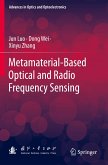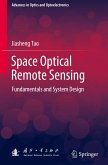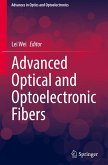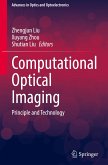- Gebundenes Buch
- Merkliste
- Auf die Merkliste
- Bewerten Bewerten
- Teilen
- Produkt teilen
- Produkterinnerung
- Produkterinnerung
This book highlights the fundamentals and practical methods of metamaterials-based optical and radio frequency sensing. Combined with engineering practices, the book illustrates in detail wide frequency electromagnetic signal cloaking and the detection behavior of metasurfaces, including the structure of metasurfaces, electric-controlled behaviors, layout design and fabrication methods, and related experiment results. This book is expected to inspire the research and development of new optical and radio frequency detectors. It is suitable for researchers and engineers working on semiconductor…mehr
Andere Kunden interessierten sich auch für
![Metamaterial-Based Optical and Radio Frequency Sensing Metamaterial-Based Optical and Radio Frequency Sensing]() Jun LuoMetamaterial-Based Optical and Radio Frequency Sensing113,99 €
Jun LuoMetamaterial-Based Optical and Radio Frequency Sensing113,99 €![Space Optical Remote Sensing Space Optical Remote Sensing]() Jiasheng TaoSpace Optical Remote Sensing83,99 €
Jiasheng TaoSpace Optical Remote Sensing83,99 €![Space Optical Remote Sensing Space Optical Remote Sensing]() Jiasheng TaoSpace Optical Remote Sensing113,99 €
Jiasheng TaoSpace Optical Remote Sensing113,99 €![Optical Metamaterials Optical Metamaterials]() Wenshan CaiOptical Metamaterials129,99 €
Wenshan CaiOptical Metamaterials129,99 €![Metamaterials Metamaterials]() Tie Jun CuiMetamaterials262,99 €
Tie Jun CuiMetamaterials262,99 €![Advanced Optical and Optoelectronic Fibers Advanced Optical and Optoelectronic Fibers]() Advanced Optical and Optoelectronic Fibers115,99 €
Advanced Optical and Optoelectronic Fibers115,99 €![Computational Optical Imaging Computational Optical Imaging]() Computational Optical Imaging106,99 €
Computational Optical Imaging106,99 €-
-
-
This book highlights the fundamentals and practical methods of metamaterials-based optical and radio frequency sensing. Combined with engineering practices, the book illustrates in detail wide frequency electromagnetic signal cloaking and the detection behavior of metasurfaces, including the structure of metasurfaces, electric-controlled behaviors, layout design and fabrication methods, and related experiment results. This book is expected to inspire the research and development of new optical and radio frequency detectors. It is suitable for researchers and engineers working on semiconductor devices, applied optics, and wide frequency signal detection. It is also a good reference for students in these areas.
Produktdetails
- Produktdetails
- Advances in Optics and Optoelectronics
- Verlag: National Defense Industry Press / Springer / Springer Nature Singapore / Springer, Berlin
- Artikelnr. des Verlages: 978-981-99-2964-1
- Seitenzahl: 256
- Erscheinungstermin: 2. Juli 2023
- Englisch
- Abmessung: 241mm x 160mm x 19mm
- Gewicht: 599g
- ISBN-13: 9789819929641
- ISBN-10: 9819929644
- Artikelnr.: 67772357
- Herstellerkennzeichnung
- Springer-Verlag KG
- Sachsenplatz 4-6
- 1201 Wien, AT
- ProductSafety@springernature.com
- Advances in Optics and Optoelectronics
- Verlag: National Defense Industry Press / Springer / Springer Nature Singapore / Springer, Berlin
- Artikelnr. des Verlages: 978-981-99-2964-1
- Seitenzahl: 256
- Erscheinungstermin: 2. Juli 2023
- Englisch
- Abmessung: 241mm x 160mm x 19mm
- Gewicht: 599g
- ISBN-13: 9789819929641
- ISBN-10: 9819929644
- Artikelnr.: 67772357
- Herstellerkennzeichnung
- Springer-Verlag KG
- Sachsenplatz 4-6
- 1201 Wien, AT
- ProductSafety@springernature.com
Guanghui Li is a professor in the School of Minerals Processing and Bioengineering at Central South University, China. He received his B.E., M.S., and Ph.D. degrees, all in Mineral Processing Engineering, from Central South University in 1996, 1999, and 2002, respectively. After completing his graduate study, he joined the Department of Ferrous Metallurgy of the school, and was promoted to lecturer, associate professor, and full professor in 2002, 2004, and 2010, respectively. Since 2018, he has been the vice dean of the school. Since 2020, he has been Specially Appointed Professor of Chang Jiang Scholar Program of China. His research interests include short process of utilization of complex iron ores, agglomeration and direct reduction of iron ores, efficient and clean utilization of solid wastes, extraction of rare and scattered metals, synthesis of functional mineral materials, and processing of low-grade aluminum- and silicon-bearing resources. He has published over 200 papers and 4 books and won two Second-Class Prizes of National Scientific and Technological Progress Award of China. Tao Jiang is a professor in the School of Minerals Processing and Bioengineering at Central South University, China. He received his M.S. degree in 1986 and Ph.D. degree in 1990, both from Central South University of Technology. Then he joined the university and served as an assistant professor (1990-1992) and full professor (1992-now). From 2000 to 2003, he was a visiting scientist to the Department of Metallurgical Engineering, the University of Utah. He has been Specially Appointed Professor of Chang Jiang Scholar Program of China since 2008 and dean of the school from 2010 to 2018. His research interests include agglomeration and direct reduction of iron ores, and extraction of refractory gold ores. He has undertaken more than 50 projects from the government and industry, including the National Science Fund for Distinguished Young Scholars Program. He and co-workersinvented the direct reduction process of composite binder pellets and three plants were set up in China based on the invention. He proposed the innovative composite agglomeration process of iron ore fines, which was put into production in Baotou Steel Company, China. He has published 320 technical papers and 6 books. He holds 35 patents and has more than 30 conference presentations. Mingjun Rao is an associate professor in the School of Minerals Processing and Bioengineering at Central South University, China. He received Ph.D. degree in metallurgical engineering and B.E. degree in mineral processing engineering from Central South University. He was a postdoctoral fellow in the laboratory of Prof. Il Sohn at Yonsei University, Korea, from 2015-2017. His research interests include extractive metallurgy of non-ferrous metals, utilization of metallurgical solid waste, and iron ore agglomeration. His doctoral dissertation was awarded as the Excellent Doctoral dissertation of HunanProvince in 2017. He won the Second-Class Prize of National Scientific and Technological Progress Award of China in 2019. Jun Luo is a postdoctoral fellow in the School of Minerals Processing and Bioengineering at Central South University, China. He received his M.S. degree in metallurgical engineering in 2013 and his Ph.D. degree in mineral processing engineering from Central South University in 2017. His research interests include hydrometallurgical and pyrometallurgical processing of base metals from low-grade, complex, and refractory ores and secondary resources. He has published more than 20 papers and holds more than 10 Chinese patents. Zhiwei Peng is a professor in the School of Minerals Processing and Bioengineering at Central South University, China. He received his B.E. and M.S. degrees from Central South University in 2005 and 2008, respectively, and his Ph.D. degree in Materials Science and Engineering from Michigan Technological University, USA, in 2012. His research interests inc
Ideas of Optical Frequency-RF Signal Detection.- Fundamentals of Terahertz Detectors.- Metamaterial Detection Methods.- Numerical Simulation of Metamaterials.- 5 Design and Fabrication of Metamaterial Devices.- Modeling of Infrared Long-Wave Detection for Metamaterials.- Metamaterial Signal Sensing Based on Continuous Terahertz Waves.- Signal Sensing of Electrically Controlled Metamaterials Based on Terahertz Time-Domain Spectra (THz-TDS).- Induction and Detection of Optical Frequency Infrared.- Induction and Detection of RF Millimeter Wave Signals.- Subwavelength Stealth Technology of Metamaterials.- Optical Frequency-RF Integrated Detection Architecture Based on Metamaterials.- References.
Ideas of Optical Frequency-RF Signal Detection.- Fundamentals of Terahertz Detectors.- Metamaterial Detection Methods.- Numerical Simulation of Metamaterials.- 5 Design and Fabrication of Metamaterial Devices.- Modeling of Infrared Long-Wave Detection for Metamaterials.- Metamaterial Signal Sensing Based on Continuous Terahertz Waves.- Signal Sensing of Electrically Controlled Metamaterials Based on Terahertz Time-Domain Spectra (THz-TDS).- Induction and Detection of Optical Frequency Infrared.- Induction and Detection of RF Millimeter Wave Signals.- Subwavelength Stealth Technology of Metamaterials.- Optical Frequency-RF Integrated Detection Architecture Based on Metamaterials.- References.








